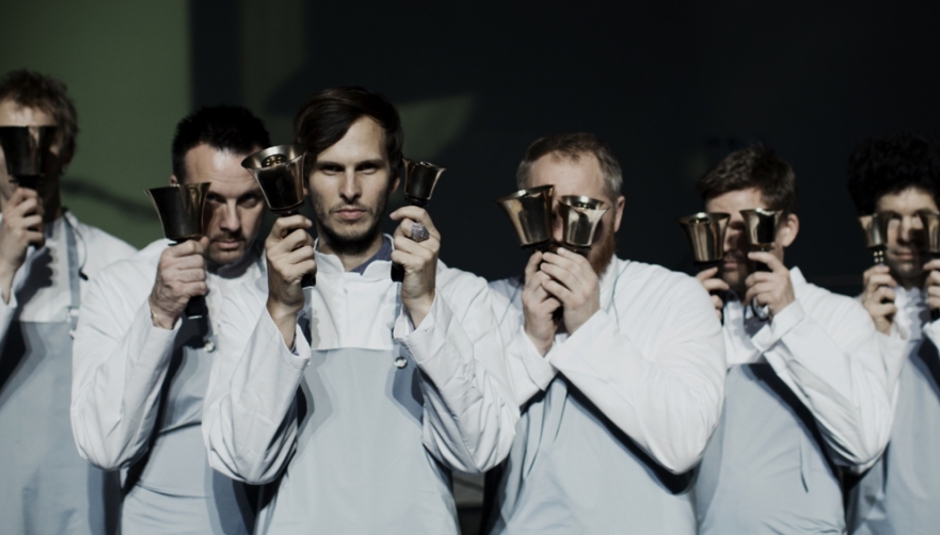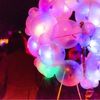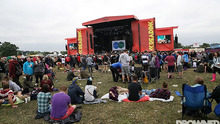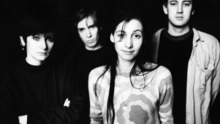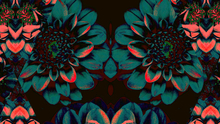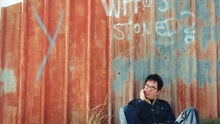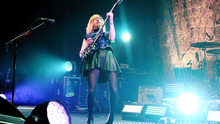Interference was the chosen theme for this year’s Unsound festival, but it’s not until we’re seated on our budget flight back to London that we can really digest its significance. As a week’s worth of experimental music draws to a close, our senses have been teased, tested and pummelled from all directions – and yet as we say farewell to a gloriously autumnal Krakow we don’t feel exhausted, but somehow profoundly refreshed.
This is what makes Unsound so special; much more than just a mouth-watering program of music ranging from the floor-filling to the Avant-Garde, it encourages wider revelations through its careful curation. The interference theme has never been more relevant than in 2013, as our lives are shaped by a cycle of constant consumption and the compulsion to share it all. We’re all guilty of it, but Unsound’s bill is designed to battle our diminishing attention spans with art that stops us in our tracks.
Of course, Unsound also takes a more literal look at interference, with much of the music exploring sonic disturbances in noise, classical and club environments. But there’s more to this theme than a vague line that joins the dots between different art forms, it feels like there’s an underlying critique of modern consumption at play. It’s not once mentioned in those terms or aggressively applied, but through a week long programme of shows, films, artist talks, panel discussions, installations and dancing until the early hours, we feel ourselves relishing in a fresh sense of perspective.
So, while we’re seeing clearly, here’s what we learnt among the interferences at Unsound Krakow.
The role of photography in live music is worth challenging
The big news ahead of this year’s Unsound was the ban on photography and filming during performances – applying to both ticket-holders and the media. The rule was not policed by the organisers themselves, but instead community “enforced” by audiences. iPad-wielding camera lunatics have been a hot topic at gigs in the last few years, replacing the resurgence of vinyl as the new dull-as-fuck pub conversation du jour. Unsound’s policy is welcome, then, for not being too strictly regulated but upheld as a simple experiment in whether the removal of photography can enhance our live experience.
The experiment works – as we look around the crowds at Unsound we see people reacting to music in all manner of different ways. During Mika Vaino’s set on the opening night at the Manggha Museum, there are groups of people sitting in the floor with their view of the stage completely obstructed – alien bass sounds being soaked up through the hard floor. In exactly the same space later in the week, there are those who excitedly invade the stage during Pete Swanson’s frantic live blend of noise and techno. As his table of equipment wobbles all over the rickety temporary stage, Swanson battles desperately to keep his performance intact. These two totally different but equally arresting sets are not documented, but will will have more impact as they are superlatively recalled through word-of-mouth, rather than in a blurry snapshot or tinny recording. Performances from the weekend are also recreated in hand-drawn sketches from festival-goers, a few of which you'll see below.
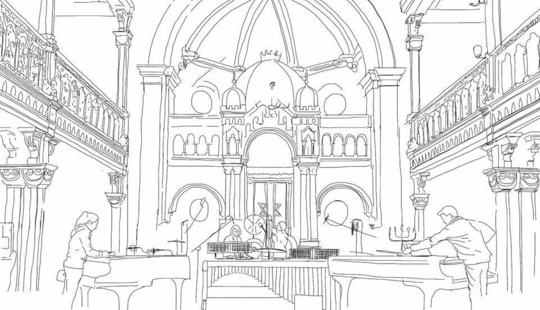
The right venue is as crucial as the right artist
Putting on great bands is one thing, but it’s easy to overlook how an experience can be shaped by its environment. As part of Unsound’s Interference theme the festival makes use of incredible everyday buildings – used for work, play, prayer and sleep – and transforms them into breathtaking performance spaces. There are grand churches, museums and synagogues, alongside basements, cinemas and the piéce de resistance – the shabby, dystopian Hotel Forum, which makes a hedonistic setting for the evening clubnights.
Juliana Barwick’s performance in the enormous St Catherine’s Church is phenomenally moving, bringing her recorded music to life with angelic, looped vocal harmonies that reverberate around the vast 14th century building. Her sparing but purposeful use of piano and guitar leave the congregation savouring every note, as a Polish girls’ choir joins in for the climactic second half. A few days later the story is very different, as Dylan Carlson’s Earth shake the foundations of an old tram shelter at the Engineering Museum with their droning lullabies. In fact, each and every venue is unique, not least the traditional Narodowy Stary Teatr in which Dean Blunt’s The Redeemer is performed in almost complete darkness – punctured by bass stabs that rattle through the theatre seats and a brief strobe section that feels nuclear in its impact.
Watch the Throne 2 is the week’s greatest interference
As we mentioned earlier, this year’s interference theme might be broadly read as an exploration of modern consumption – but it was also interpreted in a range of different ways by the week’s performers. Perhaps most fascinating of all is Wednesday night’s impromptu piano jam between James Ferraro and Dean Blunt in the tiny basement of Kazimierz’s trendy Alchemia bar. Playfully billed as ‘Watch the Throne 2’, anticipation was high to see what these two famously enigmatic artists might concoct, heightened further as we enter the venue to find tables and chairs laid across the floor in the style of a traditional jazz club. There’s even ashtrays scattered around, and as the crowd continues to wait the room quickly fills with thick cigarette smog. At last, Dean Blunt arrives calmly on stage to announce that this isn’t a ‘concert’ after all, encouraging the expectant audience to be as rude as possible as the pair improvise sorrowful piano ballads.
Not everyone seems happy to play along at first, and the room is split between those impatiently shushing and others who chat amongst themselves and enjoy the atmosphere. Eventually it sinks in, and what follows is one of the most enjoyable evenings of the week, as Ferraro and Blunt set a moody context for a crowd to get gradually drunker under the influence of strong Polish beer. This might not be Kanye and Jay Z, but in subverting Watch the Throne’s emphasis on the performer the duo manage to conjure something even more special.
The polish underground is thriving on its own terms
Polish music is rightfully well represented at Unsound, celebrating a wealth of local talent that’s beginning to make a small dent outside the country’s borders. But if we learn anything about Polish music during the week, it’s that it will succeed on its own terms and not by pandering to the west. In a frank panel discussion ‘Polish Underground Music: Breaking Through’, musician Kuba Ziolek (Stara Rzeka, Innercity Ensenmble) talks of his experiences of playing large US festivals – basically, great holidays at the expense of the Polish taxpayer, but the early afternoon performance slots are not conducive to breaking through. Meanwhile, Poland’s own festivals Off and particularly Unsound present much better opportunities for Polish bands through higher billings and the growing pull of international crowds.
As well as three Polish showcases throughout the week, our local highlights come from festival opener Anna Zaradny and post-classical quartet Kwadrofonik (pictured above). Zaradny’s disorientating set in Manggha builds a tense wall of sound out of piercing car horns, while Kwadrofonik’s unorthodox two pianist, two percussionist set-up in the ornate Tempel Synagogue manifests in an intricate but tranquil piece inspired by Polish folk music.
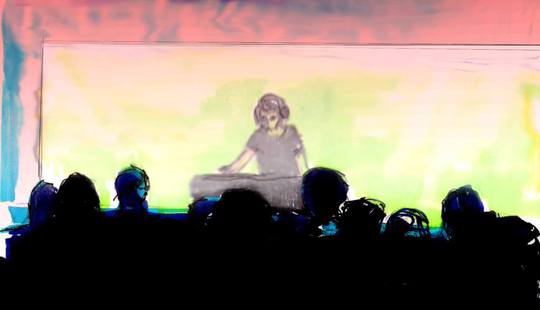
Soup and techno are best enjoyed separately
We’re big fans of soup here at Drowned in Sound, but not until Unsound had we considered taking our thermos into the club. It’s for good reason, as we rock up to the Hotel Forum on Thursday night to find a soup kitchen and a canteen serving goulash meal deals from the edge of the dancefloor. Now, the Hotel Forum is not an ordinary venue – there also seems to be two clothing shops open next to the cloakroom – but as people dance around with pizza bread aloft on the first of four major club nights, it’s actually really gross. Almost gross enough to put us off a deafening and anarchic closing set from King Midas Sound, but not quite.
Thankfully, by Friday night the soup kitchen has been carted off so we can enjoy a night of wall-to-wall techno of the highest order. There’s Laurel Halo, whose meticulously deconstructed beats serve as brain candy to warm the crowd, before a quadruple-headed 4/4 hypnosis from The Mulholland Free Clinic takes over – consisting of Move D, Juju & Jordash and Jonah Sharp. But it’s Werk’s Helena Hauff who wins the evening – not for the first time this year – overcoming some early technicals to deliver another scintillating set of acidic dancefloor destruction.
Noise and rap don’t belong together either
We love noise, we love rap – and as such, we’re willing to give LA’s noise-rap fusionists clipping. a chance. We’ve even respectfully observed their tedious grammar quirks. Ultimately, though, the group’s Thursday night set is more infuriating than it is revelatory. The group’s MC Daveed Diggs is by no means a bad rapper, and from a technical standpoint his live mic skills would have been impressive in another context. As they are, however – smothered in blasts of obnoxious white noise – they remind us less of the things we love about the two genres, and more of a high school punk band trotting out off-key Rage Against the Machine covers.
Sure, an experimental Polish music festival might be the last place you’d expect to find a genuine rap moment to cling on to – but Saturday night somehow delivers. Arca’s set in Room 2 of the Hotel Forum builds emotive strings and gunshots into a sort-of broken party rap, before Evian Christ mends the a capellas to complete the picture. His set culminates in selections that range from Young Thug and Kevin Gates to Kanye’s ‘Bound 2’ – demonstrating the increasingly blurred lines between contemporary rap and the Avant-Garde. Catch us pirouetting on the spot as we hear Young Thug’s ‘Pikacho’ from the next room, momentarily leaving behind our friends, and shortly after, our dignity.
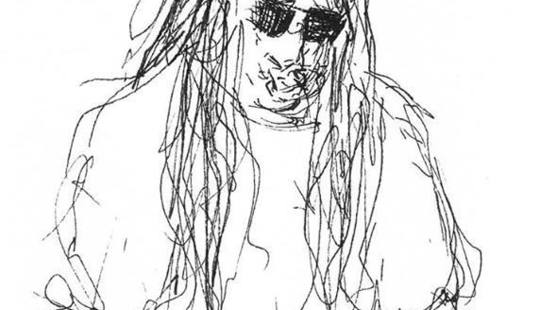
RP Boo is the world’s happiest DJ
Our favourite performance at The Hotel Forum comes from RP Boo, who delivers frenetic footwork with an enthusiasm that’d make Lunice or David Rodigan look shy. His set is a turning point for the weekend as the pummelling techno of the night before ascends into a full-on party vibe –expertly chopping vocal snippets into drums that jolt around seemingly of their own accord. As revealed in his artist talk, It’s RP Boo’s first trip out of the US and he’s not about to make it a wasted trip – running around the mixing desk in regular intervals to land hi-fives with flailing limbs. He seems visibly overwhelmed that this radical, localised music is making an impact outside of Chicago, and his passion for it is contagious. Even if footwork isn’t your thing, it hardly matters – his energy levels alone are enough to send the 2am crowd into a joyfully rhythmic spasm.
Pantha Du Prince & The Bell Laboratory is the ultimate hangover cure
Waking up with a thumping headache on our last day of Unsound was inevitable, but what we hadn’t expected to find was the ultimate hangover cure. If we’re completely honest, our enthusiasm for Pantha Du Prince has dwindled since he decided to go ‘full bells’ – yet as we watch him perform in the Engineering Museum with The Bell Laboratory we realise the error in our ways.
It’s the festival highlight, as a week of dense and challenging music transforms into a melodic haven that panders to your every sense. It feels like a warm hug of an afternoon techno set – the crowd cheering into each 4/4 surge so that you can literally hear the release of tension in the room. Everything begins to make sense again in those moments, and as the group walk through the crowd ringing their gorgeous handheld bell melodies all around the room – it’s an emotional ending to a truly transcendent week of art and music.
--
All images drawn by festival-goers and taken from the Unsound photo stream.

